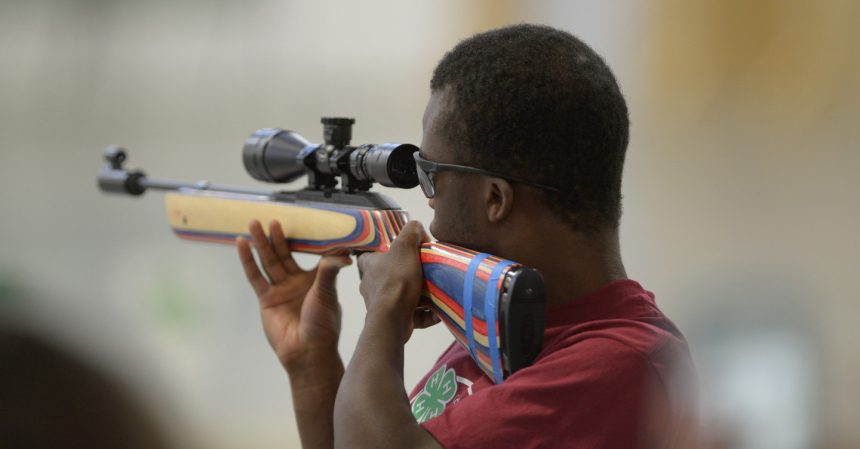The Summer Olympics shine a spotlight on the growing popularity of archery and firearm target shooting, activities which benefit the conservation of wildlife in a big way. (Title image: A contestant at the 4-H Shooting Sports National Championships).
By Jim Curcuruto, Executive Director, Outdoor Stewards of Conservation Foundation
Whether it’s plinking peach cans, punching holes in paper, busting clays, or the leaden clank of a bullet on steel downrange, target shooting is an immensely popular pastime—and it’s growing. The numbers bear that out. In 2020, 56 million Americans went target shooting with a firearm—a 34-percent increase since 2009—according to research conducted by Responsive Management, a survey research firm specializing in attitudes toward natural resource and outdoor recreation issues. The National Sporting Goods Association reports that more people participate in target shooting than soccer, tackle football and baseball.
The reasons are many: comradery with friends and family, honing skills and improving accuracy, practicing for self-protection or home defense, participating in friendly or professional competitions, and preparing for hunting season. Target shooting can be enjoyed by just about anyone of any age at any skill level—novice to professional.
From “turkey shoots” to the Olympics, competitive target shooting has been popular for generations and longer than you may know. Shooting was one of the original ten Olympic events. The First Olympiad games in 1896, Athens, Greece, hosted sixty-one shooters from seven nations vying for medals in five events. American brothers John and Sumner Paine took home three medals, including gold and silver in the 25-metre military pistol.
The tradition of success continues. Olympian Kim Rhode is a six-time medalist, including three gold medals. Rhode is the first summer Olympian to win an individual medal at six consecutive games, and the first woman to medal in six consecutive Olympics. This summer our American athletes will compete in 15 Olympic shooting events with pistol, rifle, and shotgun.
Target shooting in outdoor clay sports (similar to some of the Olympic events) is currently one of the fastest growing high school and collegiate sports in the U.S. The Scholastic Clay Target Program and USA Clay Target League have seen 25 percent increases in competitors and no end to the recent surge.

Target shooting benefits conservation in a big way. The firearms and ammunition manufacturers supplying America’s 56 million target shooters pay a 10- to 11-percent excise tax on their products through the Wildlife Restoration Act of 1937 (Pittman-Robertson). In just the past five years, these excise taxes have exceeded $3.5 billion—money administered the U.S. Fish and Wildlife Service’s Wildlife and Sport Fish Restoration program that state wildlife agencies use for wildlife management and restoration, research, habitat improvement, land acquisition, hunter access, and hunter education safety training. With obvious symmetry, the excise taxes also pay for public shooting range development and maintenance.
A steady or increasing market demand from target shooters ensures a steady and reliable funding source for conservation, and more public shooting ranges. Target shooters range from plinkers to pros and all of them taken together exert a market demand that translates to large benefits for commerce and conservation.
What Manufacturers are Doing about R3

Since the start of 2020, more than eight million American’s became first-time gun owners and millions more have a strong interest in purchasing their first gun. Like many activities, it can be hard to get started without some help. First-timers need information on firearm safety, rules and regulations, operating firearms and where to go for training. Manufacturers such as Ruger, Smith & Wesson and Federal Premium along with groups like NRA and IHEA-USA are posting information and instructional videos for beginners on their websites as a way to get information to them.
Groups such as Scouts, 4-H Shooting Sports, and Izaak Walton League offer introductory courses and leagues and are a great place to start. Local shooting ranges and sportsmen’s clubs have beginner leagues that will offer additional options to new gun owners as well. State and federal wildlife agencies are terrific resources and manage more than 600 public shooting ranges across the country.
The National Shooting Sports Foundation manages www.WhereToShoot.org which lists 7,000 ranges across the US and they also operate National Shooting Sports Month every August so be sure to check out all the resources available to you.
Research has proven that the most effective way to continue to grow target shooting and make it open to all is to have experienced target shooters simply invite a newcomer to the range with them. If you’ve got plans to head to the range soon, be sure to extend an invitation to a neighbor, co-worker or friend, and have fun teaching someone new.

